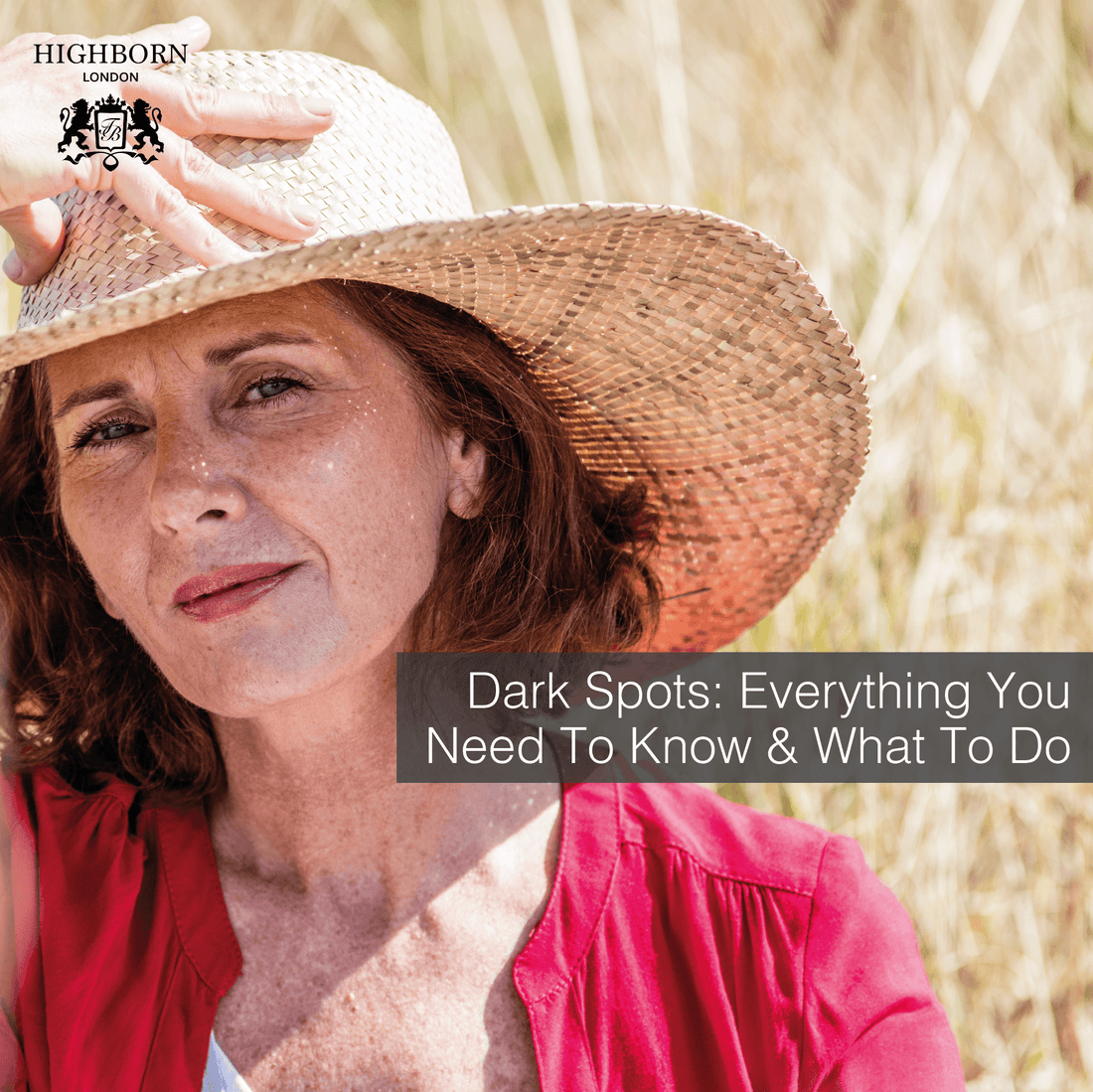
Pesky Dark Spots - Here's Everything You Need To Know
Share

Been wondering about those dark, uneven patches of skin on your face? You’re not alone. Dark spots are very common indeed. In fact, uneven skin tone is one of the biggest skin concerns in the UK. But that doesn’t make it any less frustrating when you’re faced with dark spots every time you look in the mirror, does it?
Otherwise known as 'hyperpigmentation', dark spots can be tricky to understand. Are they caused by too much sun? Are they a sign of a health issue? And why do they get worse as you get older? Here, we break down everything you need to know about your dark spots, from the most common types to the best ways to prevent and treat them.
So, let’s get to it. We’ve a lot of ground to cover ...
What Is Hyperpigmentation?
Hyperpigmentation is a condition in which small patches of skin become darker than its surrounding skin. It can affect anyone, with any skin colour. And yes, it’s usually more prevalent on areas of skin that have been excessively exposed to the sun – more on that later…
So, what causes hyperpigmentation? In a word, melanin.
Melanin is the natural pigment that determines the colour of your skin, hair and eyes. It’s produced by special cells in your body called melanocytes which usually work like a well-oiled machine.
But, note the word ‘usually.’ Problems start when melanocytes become disrupted by external or internal damage which, in turn, makes them overproduce melanin and results in patchy, uneven skin, aka hyperpigmentation.
What Are The Different Types Of Hyperpigmentation?
There are three main types of hyperpigmentation or dark spots: 'sun spots', 'melasma' and 'PIH' (post-inflammatory hyperpigmentation).
1. Sun Spots [aka age spots or liver spots]
Technically known as solar lentigines and historically called liver spots, sun or age spots are small, flat patches on the skin that are usually dark brown or greyish in colour. There are no prizes for guessing what causes sun spots as they’re most commonly found on your face, hands, chest, shoulders and arms which, no surprise, are the areas most exposed to the sun.
Sun spots can appear at any time in your life, but they’re more prevalent in adults over 50 who have paler skin and have spent years worshipping that great, but oh-so-damaging ball of fire in the sky.
2. Hormone-Triggered Melasma
Melasma is brown or grey, but it’s normally paler than sun spots and is often symmetrical on both sides of your face. It may also be seen on your shoulders, neck and forearms.
Usually triggered by an imbalance of hormones, melasma is most commonly found on the face – around your mouth, forehead, cheeks or nose. Around 90 percent of melasma cases are found on women where it often appears during hormonal changes such as throughout pregnancy, menopause or while taking the contraceptive pill.
Melasma may also be called chloasma or, when it occurs during pregnancy, you might hear it referred to as ‘the mask of pregnancy.’
3. Injured or Scarred Skin – PIH [Post-Inflammatory Hyperpigmentation]
Post-inflammatory hyperpigmentation is the most common type of dark spot and although it can appear on both men and women equally, it’s especially prevalent on people with darker skin tones. It can range in colour but is usually pink, red, purple, brown or black depending on your skin tone and the depth of the damage.
PIH appears when damage and inflammation occurs to your skin following some kind of trauma or injury. This can be anything from acne or a burn through to insect bites, eczema or improper use of powerful, light-based skin treatments such as laser therapy or IPL.
As your skin heals, it produces too much melanin which discolours your skin and leaves a scar in its wake. Unlike true acne scars, however, which are pitted, depressed or raised, PIH is flat.
Take note, the more inflamed the original trauma was, for example, the larger and darker your PIH will be. So, picking your spots or scratching at eczema? Bad idea.
How To Treat Dark Spots
To help fade dark spots, an effective skincare routine is always the best place to start. Some types of dark spots can disappear on their own – especially if you employ a strict daily SPF skincare routine (more on that below), but hard-working skincare will speed up the waiting game and help your dark spots fade much quicker.
Our top tips for fast-tracking? Make sure you exfoliate regularly with a gentle but effective scrub like our Natural Luminosity Scrub. You could also try a cleanser that contains alpha-hydroxy acids (AHAs) like glycolic, lactic or citric acid – a key ingredient in our luxurious Crystal Cleanser.
Similar to physical exfoliators like scrubs or cleansing brushes, AHAs increase cell turnover and encourage the shedding of dead, discoloured cells from the surface of your skin to help improve the tone and texture of your complexion.
Applying vitamin C is another must because vitamin C not only helps fade pre-existing dark spots by hampering melanin production, but also protects your skin from free radical damage and any resulting pigmentation issues.
You can get your daily fix with our Pre-Eminent Beauty Serum which combines vitamin C with retinol to further boost cell turnover, accelerate collagen production and reduce dark spots. Organic Age-Defying Facial Oil is also packed with vitamin A, C and E help to target pigmentation for a more even skin tone. Hooray!
What’s The Best Line Of Defence Against Dark Spots?
Experts agree that protecting your skin from UV damage is the single most important way to prevent any type of hyperpigmentation. Granted, the sun doesn’t specifically cause PIH and melasma (unlike sun spots, of course), but it’ll make them ten times worse if you don’t wear a broad-spectrum SPF every day. Better still, add a hat and sunglasses for even more protection.
If you want to instantly even-out your dark spots AND protect your skin, you might want to try our luxurious Organic Tinted Moisturiser with SPF 25. It's been so popular it sold out very quickly but you can join the waitlist to be the first to know when more shades are back in stock!
Should You Be Concerned About Your Dark Spots?
This is a common question and the good news is that dark spots are typically harmless. Are ‘liver spots’ a sign of liver disease? Not proven and most likely named this simply because of their colour. But if you’re worried about certain dark patches on your skin – especially if they’re itchy, bleeding, inflamed or irregular in colour or shape – always seek advice from your GP.
And remember, your biggest and most important job is to make sure you protect your skin with SPF, even a hat too, every day.
Finally, note that dark spots require time before they’ll fade and (fingers crossed) disappear, so don’t panic when they’re not gone in a week. Be patient and give your skincare regime at least six weeks to start noticing a difference.

3 comments
Good explanation on dark spots, particularly how ingredients in the products work – thank you.
Thankyou do much for the blog, happy to hear dark spots can fade and glad you encourage people to wear a hat as well as sunscreen
Very useful blog as 50+ & very reassuring information why skin is changing nd how is occurs